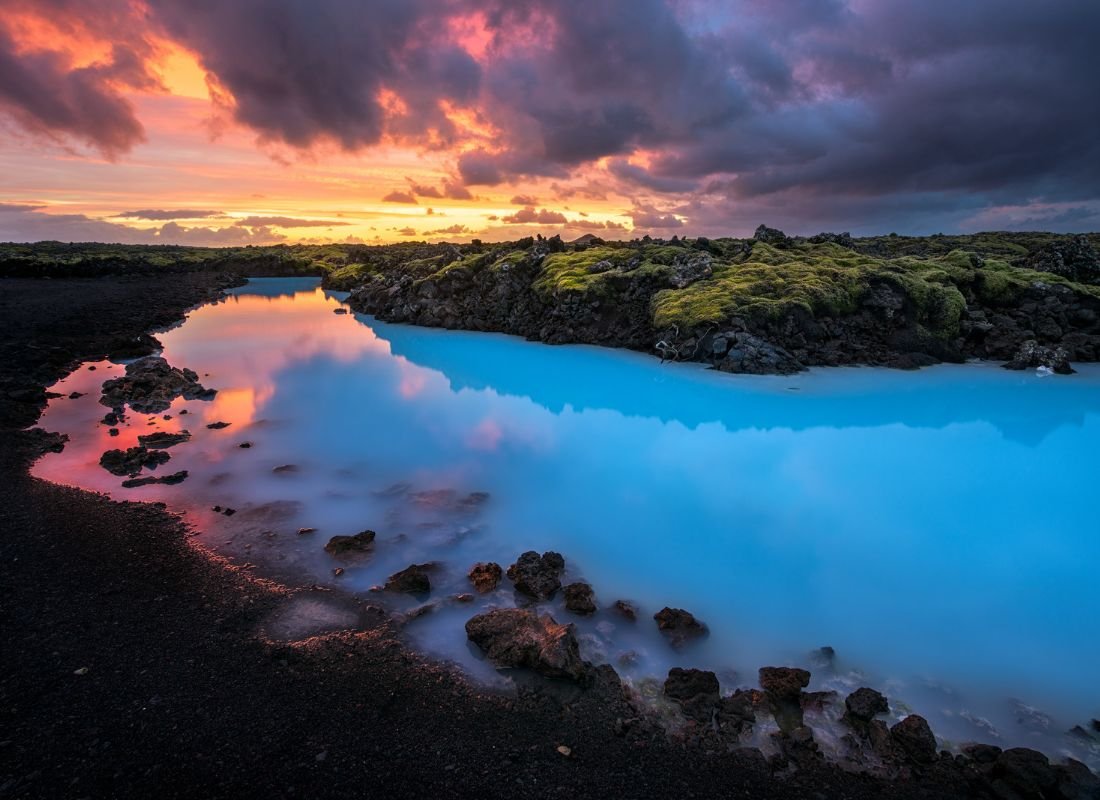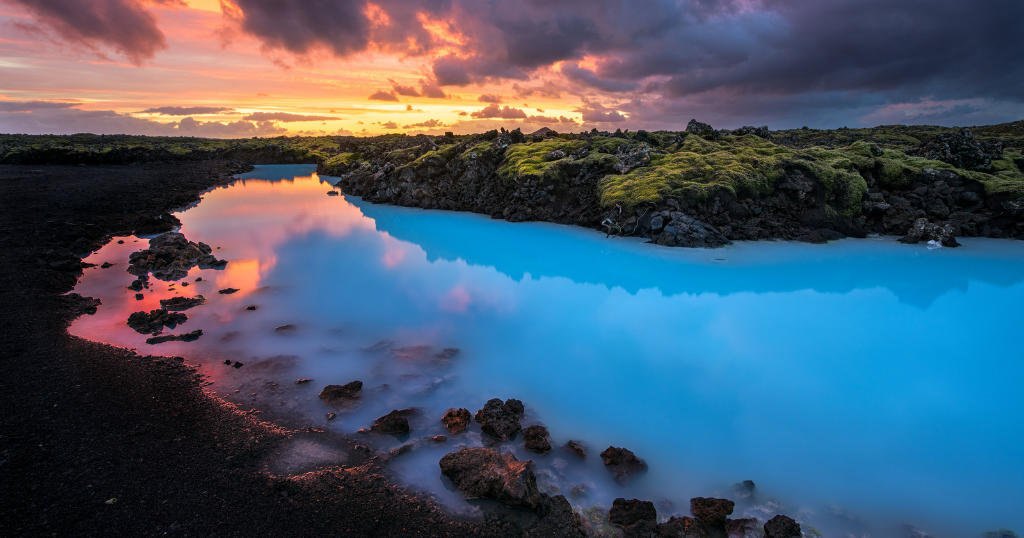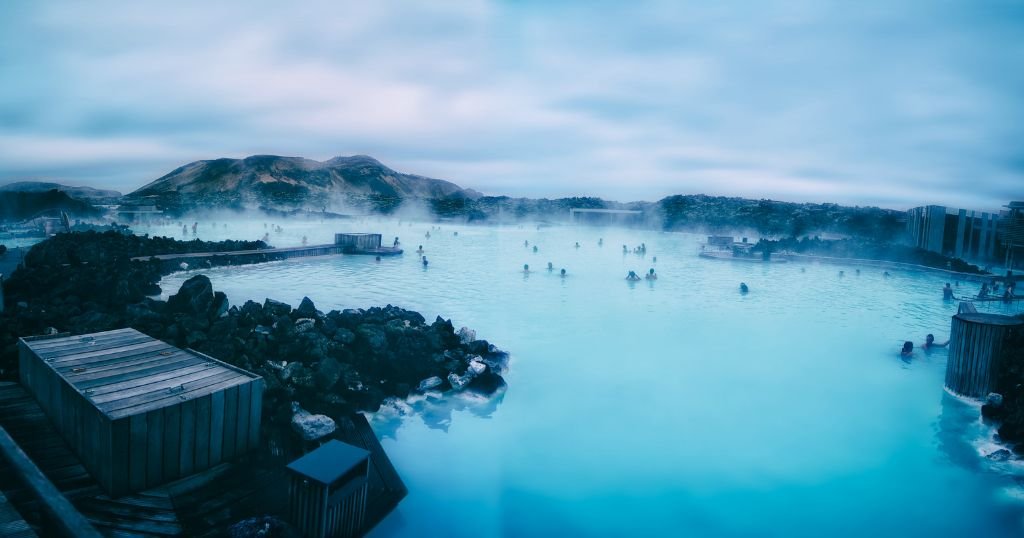
Blue lagoon
Iceland’s geothermal bath, the Blue Lagoon, has become a global emblem. It attracts tourists from all over the world with its soothing waters and beautiful scenery. This detailed blog entry discusses the Blue Lagoon’s history, how to maximize your stay, and its impact on the ecosystem. Come explore the Blue Lagoon with us, whether you’re planning a trip there or just want to learn more about this incredible place.
History and Formation
The history of the Blue Lagoon and how it came to be a tourist attraction

It was formed in 1976 as a consequence of the construction of a local geothermal power plant. The plant’s mineral- and silica-rich effluent eventually formed a lagoon in a nearby lava field. At first, many people avoided the lagoon because of its bad associations, and some even threw waste from companies into it.
They eventually discovered that the mineral-rich water was excellent for treating skin illnesses such as psoriasis. The lagoon first saw tourists in the 1980s, and it quickly became famous as a swimming spot for both inhabitants and visitors.
Since 1992, the Blue Lagoon Company has managed and developed the property, making it a global spa and health destination. As a hallmark of Iceland’s distinctive geothermal terrain, the country welcomes over a million people annually.
The geological formation of the Blue Lagoon and how it became a natural hot spring
The Blue Lagoon in Grindavk, Iceland, is a geothermal spa built amid a lava field. Its location on the volcanically active Reykjanes Peninsula is a major draw. The lagoon receives water from the Svartsengi geothermal power plant 2,000 meters (6,500 feet) below.
Due to Iceland’s Mid-Atlantic Ridge, geothermal activity heats the sea. The power plant’s hot water contains silica, sulfur, and algae, which give the lagoon its signature blue-green hue.
The lagoon’s water temperature is 37–40 degrees Celsius (98–104 degrees Fahrenheit), making it a great place to relax. Psoriasis and eczema sufferers may get relief from the mineral-rich water’s medicinal properties.
Since geothermal water has continued to flow into the area, it has gradually transformed into a natural hot spring. Through continual recharging and recirculation, the water in the lagoon is kept pure and pristine.
Interesting facts or legends surrounding the Blue Lagoon
Blue Lagoon stories are fascinating.

Blue Lagoon water is really milky white. Water is blue because silica particles reflect sunlight.
Vacationers used to avoid it. It was such a nuisance that industrial waste was dumped there.
A group of giants fought over a valuable treasure, creating the Blue Lagoon. The fight accidentally fractured the Earth’s crust, releasing geothermal energy that produced the lagoon.
The Blue Lagoon may treat psoriasis and eczema, among other skin disorders. The water’s silica and mineral content may help enhance skin.
“Die Another Day” and “Game of Thrones” have Blue Lagoon sequences.
Location and Accessibility
The location of the Blue Lagoon and how to get there
Around forty minutes’ drive from Iceland’s capital, Reykjavik, you’ll find the Blue Lagoon in the country’s southwestern corner. It is located on the Reykjanes Peninsula, in the center of a lava field, not far from the town of Grindavik.
You may reach the Blue Lagoon in a number of different ways:
- The Blue Lagoon is most easily reached by automobile. There is plenty of parking available, and signs point the way from the main road.
- Shuttle bus: Getting from Reykjavik to the Blue Lagoon is easy since there are several shuttle bus routes. You may schedule a ride on one of these buses in advance, and they operate many times daily.
- Many city tour companies visit the Blue Lagoon on their Reykjanes Peninsula and Golden Circle trips.
The opening hours and admission fees

The Blue Lagoon is open seasonally year-round. I found the following business hours in September 2021:
January 1–March 31: 8:00 a.m.–10:00 p.m.
We’re open 8:00AM–11:00PM April 1–May 31
June 1–August 31: 7 a.m.–12 a.m.
September 1–December 31: 8:00 a.m.–10:00 p.m.
Please check the website to confirm the current hours of operation.
Your package determines the entrance price. Common options include:
Adult entrance includes a towel and silica mud mask for 7,990 ISK (approximately $63 USD).
For 16,990 ISK (about $134 USD), adults may get a private changing room, a bathrobe, slippers, towel, silica mud mask, a beverage of their choice, and a dinner reservation at the spa’s Lava restaurant.
Facilities available on site
In order to maximize your time at the Blue Lagoon, they provide a number of amenities, such as:
- The on-site Lava Restaurant provides guests with an unforgettable culinary adventure and breathtaking views of the lagoon. There are a number of additional dining and drinking establishments spread out over the site.
- Lockers and showers: The Blue Lagoon features large locker facilities with showers, hair dryers, and vanity mirrors. While you’re having fun in the lagoon, you may leave your valuables in a locker.
- A variety of rejuvenating spa treatments are available at the Blue Lagoon’s five-star spa. There is a wide variety of services available, from massages done in the water to full-body wraps and facials.
- The gift shop provides mineral-rich water, skin care products, garments, accessories, and other presents.
- Individuals and small groups alike may make use of the Blue Lagoon’s private changing rooms, lagoon areas, and spa suites.
In addition, there is an observation platform with a 360-degree panorama of the lagoon, as well as free Wi-Fi and outdoor dining places.
The Blue Lagoon Experience
There is more than a spa—a complete retreat in a beautiful natural location. It offers:
- The Reykjanes Peninsula’s volcanic landscape and the lagoon’s azure waters await you. After checking in and receiving a wristband, go to the locker facilities to change for the lagoon.
- The lagoon is the Blue Lagoon’s main draw. The milky blue waters’ silica and sulfur may alleviate skin and body ailments. When you wade in the warm waters, your tension will evaporate, and the tranquil environment will settle your mind.
- A silica mud mask is one of the most intriguing of their activities. Lagoon minerals revitalize and exfoliate this natural mask.
- Spa packages provide a range of soothing treatments. Massages, body cleanses, facials, and more help you relax at the spa.
- The Blue Lagoon’s restaurants may provide a fast lunch after a long soak or a romantic dinner for two. Fresh Icelandic fish and gourmet meals are delicious and well presented.
You should leave there refreshed and at peace. You’ll admire nature’s healing power and have amazing encounters.
Environmental Impact

Despite the Blue Lagoon’s beauty and peacefulness, its fast development has raised concerns about environmental degradation. Blue Lagoon’s environmental issues include:
- Water Consumption: A nearby power plant supplies geothermal seawater to the Blue Lagoon, a man-made lagoon. The lagoon’s popularity has increased water usage, which may harm the ecology.
- Garbage: Visitors to the Blue Lagoon leave a lot of trash. Some fear that visitor-used chemicals and other things are harming the lagoon despite its strict waste management program.
- There is clean geothermal energy. A nearby geothermal power plant generates carbon dioxide and other greenhouse pollutants while powering the lagoon.
- Construction and expansion of the complex changed the landscape everywhere. Numerous individuals say the construction has damaged the surrounding ecology and wildlife.
- History and culture surround it. Others say the lagoon’s growth has encroached on important archaeological sites, threatening the region’s cultural legacy.
Conclusion
In conclusion, the Blue Lagoon is a unique and mesmerizing natural wonder that has become one of Iceland’s top tourist attractions. Its geothermal seawater and natural beauty offer visitors a one-of-a-kind relaxation and wellness experience. The popularity of the show has raised environmental concerns about water, waste, electricity, gardening, development, and cultural heritage. To address these issues,it has created sustainability initiatives and is committed to environmental monitoring and research. There is a must-see attraction in Iceland, but tourists must conduct environmentally friendly tourism.

